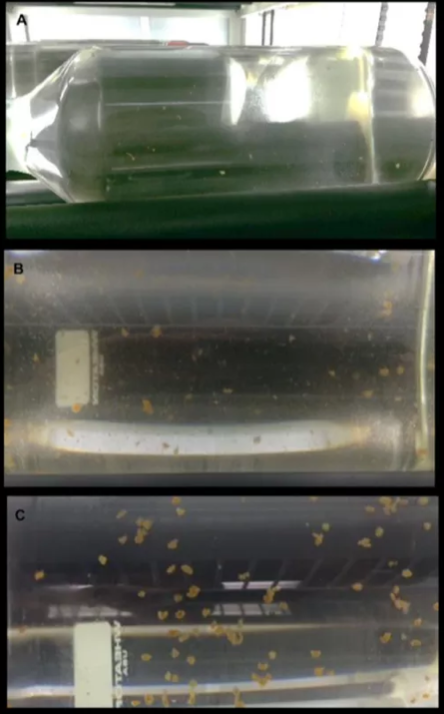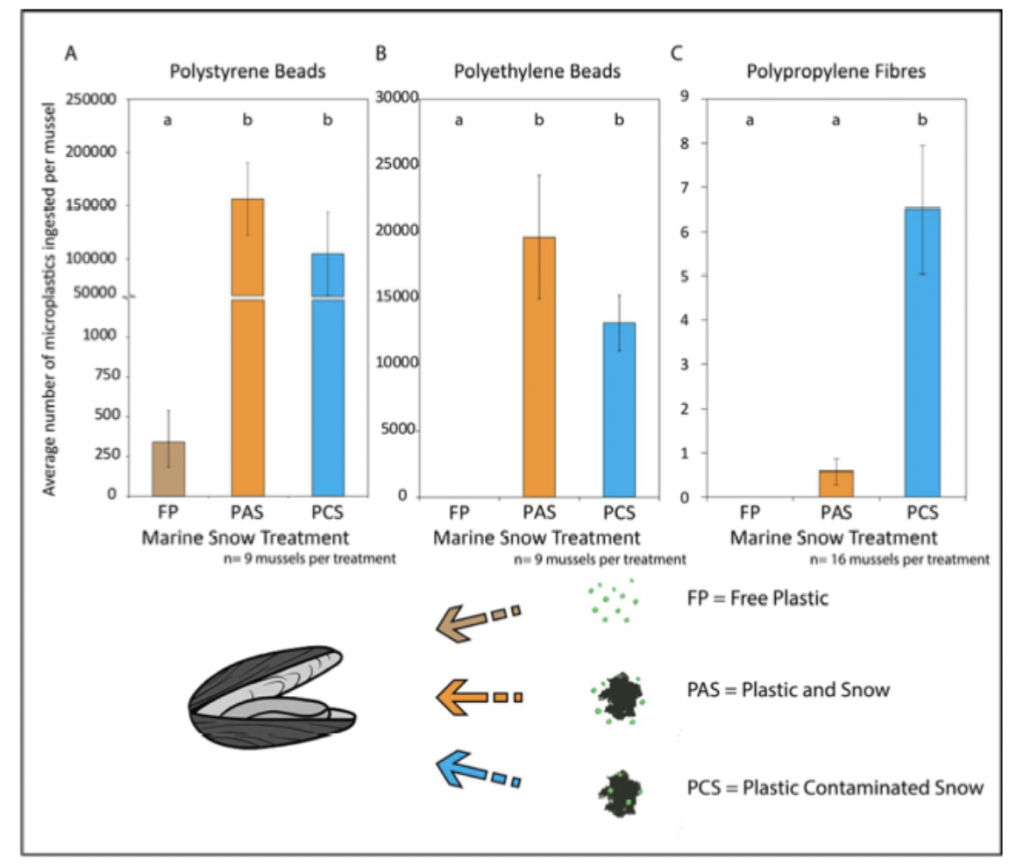Porter, A., Lyons, B.P., Galloway, T.S., Lewis, C. (2018). The role of marine snows in micro plastic fate and bioavailability. Envrion. Sci. Technol. DOI: 10.1021/acs.est.8b01000 https://www.researchgate.net/publication/325277618.
Marine Snow Moving Plastic
Most estimates microplastics cover the surface ocean because it is more challenging to measure the amount of plastic on the

seafloor. However, studies have estimated large quantities of plastic at depth. In fact, plastics that typically float at surface have been observed as deep as 5000 m and even found in some benthic (bottom dwelling) organisms (Woodall et al., 2014). Computer modeling studies predict 99 percent of plastic in the ocean will eventually reach the bottom of the ocean (Koelmans et al., 2017). However, it is not well understood how the plastics reach the seafloor, especially considering some types of plastic float. Previous studies have not yet considered how marine snow might act as the Uber driver for plastic from surface waters to deep dwelling creatures. This is where Dr. Porter and team step in.
One natural process of transporting material to the deep ocean is called the biological pump, where organic particles at the
surface ocean can reach the deep ocean. Dying tiny marine organisms or more compact excretions from these organisms clump together forming what is called marine snow. Since these particles are really many particles combined into one, they are more dense and able to sink to the deep ocean. This natural transport of material to deep water sparked the authors’ prediction that when plastic mixes with the clumps of marine snow, these particles will bring the plastic along for the ride to the deep ocean.
The Experiment – Let it Snow…
The authors made marine snow in the laboratory and incorporated different types of commonly found plastics of varied shapes and sizes. Marine snow was made by rolling bottles of seawater and plastic to clump together organic particles in the water, referred to as aggregation. They rolled bottles for 3 days at 14 rotations around per minute. Figure 1 shows an example of how marine snow was made in another study by Schnetzer et al., 2017.
They made marine snow both with and without plastic. The marine snow with plastic also was varied by type of plastic, such as fibers or small beads. Each of the different types of marine snow were added to a tube of water and allowed to settle down. As the particles sank, they would capture pictures of the particles using your basic camera and compute how many frames it took the particles to settle a predetermined distance. They divided by the how often the pictures were taken to determine how long it took the particles to settle. From this information, they computed a settling speed by dividing the predetermined distance by the time it took the particles to settles.
They also computed relative sinking rates, which means that they would estimate how fast plastic particles alone would sink in comparison to how the fast the marine snow with these plastic particles was measured to sink.
While it’s interesting to measure how quickly this plastic polluted marine snow sinks, why do we care? Once the plastic sinks to the bottom of the ocean, it could be taken up by bottom-feeding organisms we eat, like mussels. To test whether mussels would consume this plastic, they exposed these organisms to different types of plastic containing marine snow described above and measured how much plastic the mussels ingested.
Results – Plastic in Your Dinner?
All types, shapes and sizes of plastic had an increased sinking rate when they were incorporated in marine snow than if they were sinking alone. Even plastics that are incapable of sinking normally because they are buoyant were able to sink when a part of marine snow.
For example, small plastic beads typically sink less than one meter per day would sink at a speed of about 900 meters per day when packed into marine snow! This suggests that marine snow could very well be the Uber driver of plastics to the seafloor (however, just like there are other companies like Lyft, there are likely other ways plastic reaches the deep ocean, too)!
In regard to whether the mussels were mistakenly eating plastic, researchers observed that when feeding the mussels marine snow mixed with plastic, the mussels ingested much more plastic than when feeding the mussels plastic alone. In other words, disguising the plastic into this organic matter tricked the mussels into eating more of it. Figure 2 shows the amount of different types of plastic (called polystyrene, polyethylene and polypropylene – letters A, B, and C, respectively) ingested by mussels. The color indicates the “food source,” plastic alone (brown), plastic and snow (orange) or plastic contaminated snow (blue). The authors found that the type of plastic influenced how much plastic mussels ingested. When fed beads, plastic and snow resulted in the greatest amount of plastic ingestion. And when mussels were provided with fibers, the plastic contaminated snow resulted in the most ingestion. This suggests that the combined presence of marine snow and plastic or the presence of plastic in marine snow could result in unfortunate consumption of plastic by mussels, and thus by humans, too!
Summary
Overall, this study addresses the important conundrum of how organisms living at the bottom of the ocean are eating plastic dinners, when much of the plastic resides at the surface of the ocean. They found that combining plastics with marine snow offers an explanation for how plastics reach the deep sea and are eventually ingested by organisms, such as mussels. Going forward, it will be interesting to see how the results from this laboratory experiment translate to direct ocean observations!

Other Resources:
Koelmans, A. A.; Kooi, M.; Lavender Law, K.; van Sebille, E., All is not lost: deriving a top-down mass budget of plastic at sea. Environmental Research Letters 2017, 12 (11), 114028.
Schnetzer, Astrid, Robert H. Lampe, Claudia R. Benitez-Nelson, Adrian Marchetti, Christopher L. Osburn, and Avery O. Tatters. “Marine Snow Formation By the Toxin-Producing Diatom, Pseudo-Nitzschia Australis.” Harmful Algae 61 (2017): 23–30.
Woodall, L. C.; Sanchez-Vidal, A.; Canals, M.; Paterson, G. L. J.; Coppock, R.; Sleight, V.; Calafat, A.; Rogers, A. D.; Narayanaswamy, B. E.; Thompson, R. C., The deep sea is a major sink for microplastic debris. Royal Society Open Science 2014, 1 (4), 140317.
I am a first year graduate student at the Graduate School of Oceanography at University of Rhode Island. I use robots and satellites to research the biological carbon pump, which is a series of processes that transfer carbon dioxide from the atmosphere into the deep ocean where the carbon is stored for long periods of time. I am particularly interested in the use of oxygen measurements to better understand how much carbon-containing material is produced by phytoplankton, tiny marine organisms, and is available for transport to the deep ocean. Learning about how much carbon the ocean stores through these processes is important to improve predictions about how climate change will impact the ocean.

